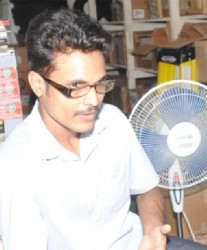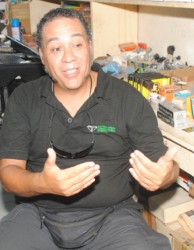In response to pressure for the complete removal of mercury from the recovery process in the global gold-mining sector, Devindra Baldeo and Jhonny Marquez have teamed up and set themselves the ambitious task of working with the local industry in the search for a mercury-free method of gold recovery.
Local miners, it would appear, are now persuaded that the recent ban on the export of mercury from North America and Europe signals the death knell of the use of the substance in the sector. And while, at this stage, the pursuit of mercury-free mining is not a dire emergency, Baldeo and Marquez believe that Guyana can no longer delay the search for a suitable option. Sooner rather than later, the pressures of a relentless international environmental lobby will catch up with what, currently, falling gold prices notwithstanding, remains Guyana’s most reliable productive sector.

Baldeo is a University of Guyana-trained chemist who operates a Regent Street business enterprise, B&M Trading; a modest but important distributor of mining supplies to the industry. Marquez is an affable Venezuela-born geological engineer whose 28 years of international experience has exposed him to the various disciplines in the mining trade in his own country as well as in Chile, Peru, Mexico, Canada and currently, in Guyana. More than that, Marquez has been associated with various local gold mining initiatives including Mahdia Gold Corp Inc and Guyana Frontiers Inc (formerly Shoreham Resources Inc) at Marudi.
When Stabroek Business met Marquez last week, he was serving as a Consultant to B&M Enterprise, as a technical functionary at the company’s demonstration of its RP4 Shaker Table for local miners.
The RP4 Shaker Table is reportedly the most widely used and successful gravity shaker concentrating table used in the gold-mining industry worldwide by both small and large mining operations. It is designed for separation of heavy mineral and gemstone concentrate down to a size of 1 micron. The RP-4 can process up to 600 lbs of material per hour with little or no loss. It utilises what is known in the mining trade as a “reverse polarity of rare earth magnets” a process that leaves pure gold travelling to the catch.
As an investor, Baldeo is encouraged by the seeming potential of the RP4 Shaker Table and during an interview with Stabroek Business last Friday he expressed optimism that local miners could begin to see it as an option.
Of particular interest to those miners who attended last week’s demonstration was the portability of the RP4 Shaker Table. Equipped with a small generator and a water tank it can be moved to remote locations with relative ease, as it requires only a supply of electricity for efficient use.

Last week Baldeo and Marquez confirmed their preparedness to work with the Guyana Gold and Diamond Miners Association (GGDMA) and the Guyana Geology and Mines Commission (GGMC) to conduct tests in the field. B&M Trading, Baldeo says, will be seeking to refocus its trading emphasis away from providing the industry with general mining supplies to offering “mining solutions”. More than that B&M Trading is exploring the possibility of establishing a station in the interior equipped to provide solutions for a range of common mining problems.
Those solutions speak to the issues of enhanced environmental practices as well as improved gold recovery methods. Marquez’s knowledge of the industry leaves him less than enamored of local mining methods, which he says leaves much of the gold that is mined – probably up to 80 per cent of it in some cases – in the tailings. Marquez says that in embracing more efficient, mercury-free mining technology, local miners will simultaneously be securing an opportunity to increase their gold yield several times over. He thumbs his nose at the 400,000-plus ounces 2012 gold declaration. “I believe that there could be up to 15 times more gold in Guyana than in Venezuela,” Marquez says. “Guyana can secure greater recovery for less investment. The technology with which to do this is not new.”
Some of the failings, Marquez says, repose in the choice of mining technology which, he says, is influenced by the mining cultures of North America and South Africa where there is a lesser volume of clay. In the absence of the prior process of removing the clay from the more gravelly material, the concentrator must work harder and becomes more susceptible to wear and tear.
Baldeo says that B&M Enterprise will shortly be breaking new ground by importing a UK-manufactured ICON IGR 3000 Concentrator specially designed to process alluvial material, including moderate clay.
Marquez points out that the IGR 3000 is particularly well-equipped to recover fine gold, a development which coincides with the need for local miners to increase their gold recovery rates (while cutting recovery costs) in order to compensate for falling prices.
The IGR 3000 incorporates a scrubber, which uses the larger rocks to break up the finer material, rendering the gold more accessible.





